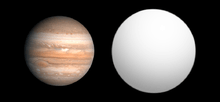HAT-P-14b
HAT-P-14b, also known as 'WASP-27',[4] is an extrasolar planet located approximately 250 parsecs (820 ly)[5] away in the constellation of Hercules, orbiting the 10th magnitude F-type star HAT-P-14. This planet was discovered in 2010 by the HATNet Project using the transit method.[1] It was independently detected by the SuperWASP project.[6]
 Size comparison of HAT-P-14b (gray) with Jupiter. | |
| Discovery | |
|---|---|
| Discovered by | HATNet Project[1] |
| Discovery date | 2010-03-10 |
| Transit | |
| Orbital characteristics | |
| 0.06062+0.00065 −0.00067 AU | |
| Eccentricity | 0.1074+0.0076 −0.0079[2] |
| 4.627682±0.000003[3] d | |
| Inclination | 83.50±0.30[1] |
| Star | HAT-P-14 |
| Physical characteristics | |
Mean radius | 1.150±0.052[1] RJ |
| Mass | 2.303±0.054[2] MJ |
The planet HAT-P-14b was named Sissi. The name was selected by Austria as part of the NameExoWorlds campaign for the 100th anniversary of the IAU. The planet was named after the character Sissi in the movie Sissi, who is married to Franz. The role is played by the actress Romy Schneider. The star HAT-P-14 is named Franz.[7][8]
Orbit
HAT-P-14b is located very close orbit to its star, taking only 4.6 days to complete one orbit. Observations of the Rossiter–McLaughlin effect with the Keck telescope show that it orbits in a retrograde fashion relative to the rotation axes of its parent star,[9] spin-orbit angle equal to -170.9±5.1°.[10]
References
- Torres, G.; et al. (2010). "HAT-P-14b: A 2.2 MJ Exoplanet Transiting a Bright F Star". The Astrophysical Journal. 715 (1): 458–467. arXiv:1003.2211. Bibcode:2010ApJ...715..458T. doi:10.1088/0004-637X/715/1/458.
- Bonomo, A. S.; et al. (2017). "The GAPS Programme with HARPS-N at TNG . XIV. Investigating giant planet migration history via improved eccentricity and mass determination for 231 transiting planets". Astronomy and Astrophysics. 602. A107. arXiv:1704.00373. Bibcode:2017A&A...602A.107B. doi:10.1051/0004-6361/201629882.
- Nascimbeni, V.; et al. (2011). "TASTE: The Asiago Search for Transit timing variations of Exoplanets. I. Overview and improved parameters for HAT-P-3b and HAT-P-14b". Astronomy and Astrophysics. 526. A85. arXiv:1011.6395. Bibcode:2011A&A...527A..85N. doi:10.1051/0004-6361/201015199.
- The Exoplanet Handbook By Michael Perryman, p.727
- Brown, A. G. A; et al. (2016). "Gaia Data Release 1. Summary of the astrometric, photometric, and survey properties". Astronomy and Astrophysics. 595. A2. arXiv:1609.04172. Bibcode:2016A&A...595A...2G. doi:10.1051/0004-6361/201629512.Gaia Data Release 1 catalog entry
- Simpson, E. K.; et al. (2011). "Independent Discovery of the Transiting Exoplanet HAT-P-14b". The Astronomical Journal. 141 (5). 161. arXiv:1009.3470. Bibcode:2011AJ....141..161S. doi:10.1088/0004-6256/141/5/161.
- "International Astronomical Union | IAU". www.iau.org. Retrieved 2020-01-02.
- "Approved names". NameExoworlds. Retrieved 2020-01-02.
- Winn, Joshua N.; et al. (2011). "Orbital Orientations of Exoplanets: HAT-P-4b is Prograde and HAT-P-14b is Retrograde". The Astronomical Journal. 141 (2). 63. arXiv:1010.1318. Bibcode:2011AJ....141...63W. doi:10.1088/0004-6256/141/2/63.
- Obliquities of Hot Jupiter host stars: Evidence for tidal interactions and primordial misalignments, 2012, arXiv:1206.6105
External links
![]()
- "HAT-P-14 b". Exoplanets. Archived from the original on 2012-04-23. Retrieved 2010-03-12.
- "HAT-P-14b in transit". Light curve using differential photometry.